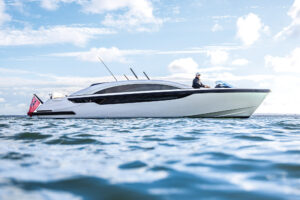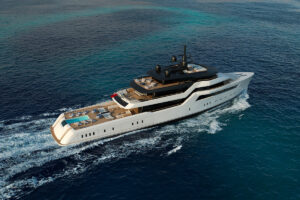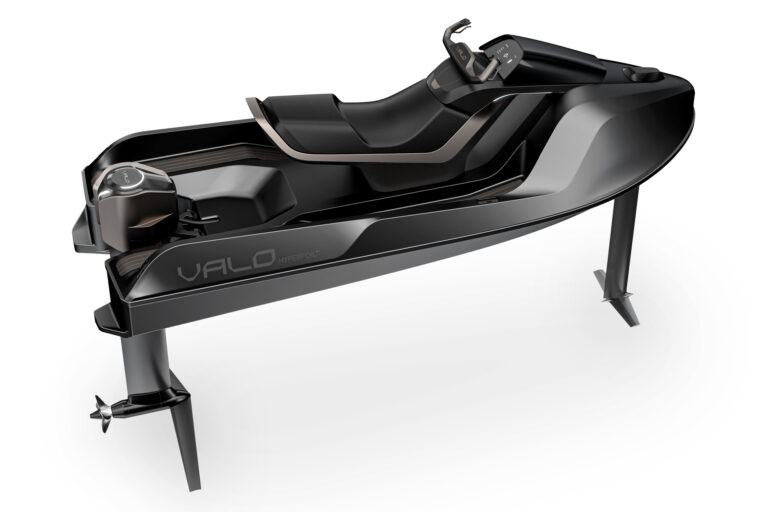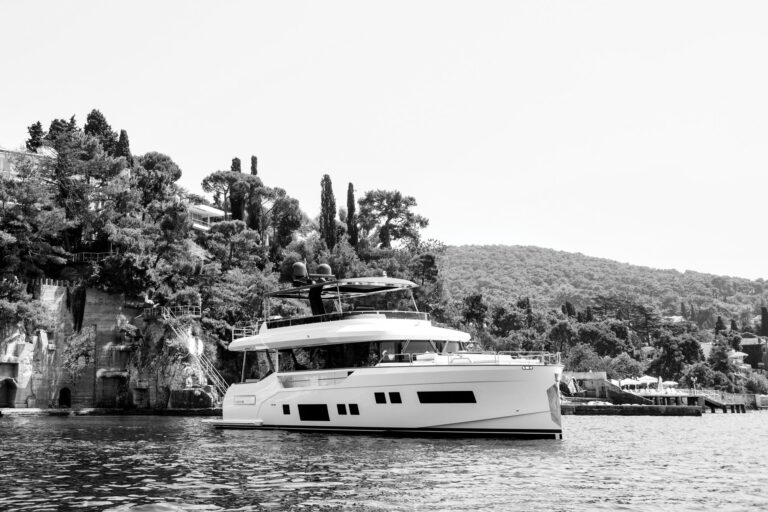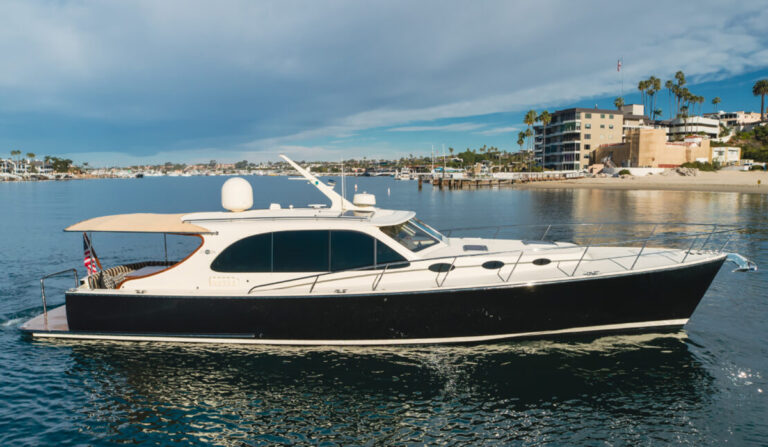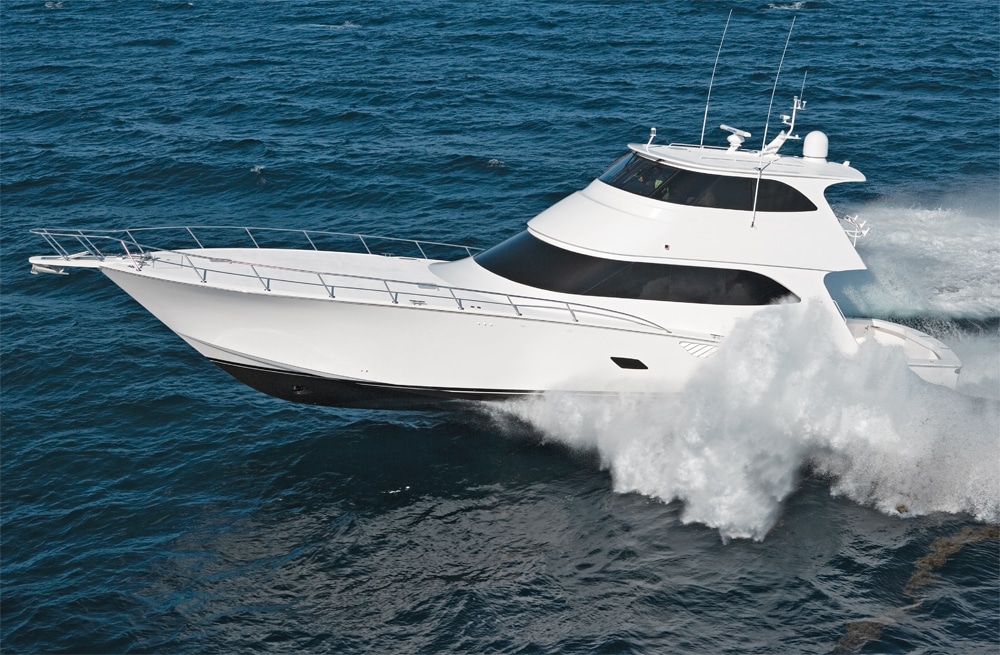
Viking 76 Enclosed Bridge
There’s no better illustration of how the market for convertibles has “grown” than the waterfront view of Viking Yachts’s service and sales facilities in South Florida. That’s where I caught up with the builder’s latest launch—the 76 Enclosed Bridge Convertible. Dockside, she dwarfs her smaller sisters in the line and she is second only to the 82 Enclosed Bridge Convertible in length overall. Without her sisters nearby the sense of scale would be lost. This balance and her eye-pleasing profile are no accident. The Healey family has been refining their products with a passion since they launched Viking Yachts 46 years ago.
I suppose I am dating myself, however, in my mind’s eye I can still conjure a rather boxy, earth-tone Viking, trimmed in maroon and fitted with a sea serpent scroll—a 40-footer circa 1974. It is the relation of these early fiberglass Viking convertibles to the new 76 that is perhaps her greatest selling point—her builder’s experience. Over the years, each new Viking I have inspected has been better than the last and, these days, you’d be hard pressed to find a better production convertible in the market. Viking’s designs have evolved at a measured pace and that is why the builder has never lost its way. Hard corners have been softened, faceted bridge faces have been rounded, and angular windows have been shaped, but the Viking DNA shines through in all its products, including the 76.
“Ninety percent of the time a new design is replacing an existing model, so we have a tangible starting point in terms of setting our goals,” explains David Wilson, Viking Yachts’s manager of design. Wilson joined the company full time in 1987, following in his father’s footsteps. In that time frame Viking has come to dominate the production convertible market. After more than four decades and with 4,200 boats built, the Viking design and engineering team has a rich library of empirical data to draw from. Wilson points out that the builder also benefits from hands-on experience. “The Healeys are boatbuilders, but they are also boaters.”
A Viking factory boat and crew always campaign the latest launches, shaking them down in the real world while keeping an ear on the dock and an eye on the competition. Wilson and his peers in design and engineering spend time aboard as often as possible. “Sea time gives all of us a chance to see what works and what doesn’t—on our boats and other boats in the fleet,” explains Wilson. Threads of these experiences are woven into the design spiral, which begins with a small, hand-picked team from the factory and the field chaired by Pat Healey, Viking’s executive vice president. It is here where goals for a new design are set and where Wilson presents a proposed profile and arrangement.

“Since the 76 replaces our 74, introduced in 2004, we had a number of styling updates in terms of the house shape and window lines,” said Wilson. With the added length and a bit more sheer height, Wilson was able to do away with the raised trunk foredeck without compromising headroom belowdecks. In addition to in-house input, Wilson was armed with a punch list generated from dealer and customer feedback. Customers, for example, wanted a full-beam master stateroom. Wilson accomplished this by adding six inches of chine beam and a bit more shape to the topsides. Storage space for the owner’s gear was also important. Wilson crafted a five-stateroom arrangement that includes a walk-in pantry forward of the galley.
A dozen revisions to a profile and arrangement are not uncommon before Wilson’s team focuses on finalizing the hull form and completing a weight study. Since tank-testing had been done on both the 74 and the 82, Wilson was confident in the 76’s form. “We haven’t made any radical changes to our hull form since the 50 Convertible in 2008,” said Wilson. “At that time, we reduced deadrise at the transom a bit to improve efficiency.” The 76 for example, has fine, slightly convex sections forward to deal with the seas, and a transom deadrise of 11.7 degrees. This makes sense for a boat of her size and speed, since when she is operated responsibly her transom should not clear the water.
A two-foot increase in length, a bit more beam, and the addition of an enclosed bridge could have had an exponential effect in terms of weight. However, the design team kept the 76’s weight in check. “Our goal with the 76 was to match or exceed the 74’s performance with the same power package,” said Wilson. To achieve this, nonstructural interior fat was trimmed and resin-infusion technology was employed on smaller components such as the fuel tanks. As was the case with the 74, the 76’s bottom, topsides, decks, and superstructure are cored with balsa. Forms for the stringers are cut in closed-cell foam and laminated in place. Cored bulkheads and web frames are built on a vacuumbagging table. “We estimate that our cored hulls are 15 to 20 percent lighter than solid-glass hulls,” said Wilson.

After spending time running the 76, it was clear that Viking’s design methodology works. Our test boat’s optional 2,400-horsepower MTUs seem a worthwhile upgrade since the 76 can use the muscle to work around a dock or a fish. She is also fitted with a bow thruster. At 1800 rpm I noted a speed of 26.5 knots. At 2100 rpm I measured 32.5 knots and the MTU electronics indicated a fuel burn of 170 gallons per hour. This should allow a range of more than 500 nautical miles with the optional fuel capacity. Cranked up, the 76 delivered 39.6 knots—impressive. Viking’s VIPER (Viking Independent Programmable Electrohydraulic Rudder) steering system controls each rudder independently, which allows engineers to dial in the ideal trailing position and toe-in. At speed, the 76 handles like a sports car.
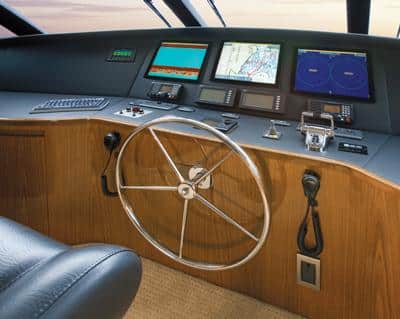
The enclosed-bridge layout will best suit cruisers who may occasionally fish, rather than hardcore tournament types that want full contact. Its climate-controlled, all-weather comfort is ideal for the long haul in challenging weather.
While some convertible builders have let their focus wander, Viking has avoided distraction and sought its inspiration on the tournament circuit. The percentage of folks who are actually tournament junkies is small, but the fact is that convertible designs have always been cross-platform performers. Viking seems to have recognized that if it built a great convertible, owners would figure out what they wanted to do with it. The 76 is a great convertible— whatever your passion.

LOA: 76’2″
LWL: 65’3″
Beam: 20’3″
Draft: 5’6″
Displ.: 136,200 lb. (w/fuel)
Fuel: 2,547 gal. (3,174 gal. optional)
Water: 425 gal.
Power Option: 2 x 1,825-hp Caterpillar C32 diesels
Test Power: 2 x 2,400-hp MTU diesels
Base Price: $5,363,000 (with 2 x 2,400-hp MTU diesels)
Viking Yachts, (609) 296-6000; www.vikingyachts.com

